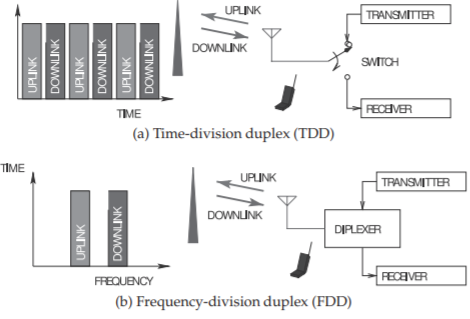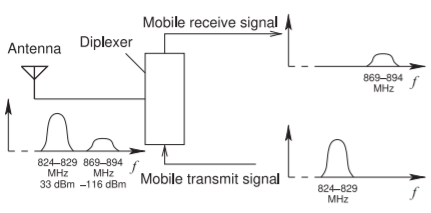5.2: Broadcast, Simplex, Duplex, Diplex, and Multiplex Operations
( \newcommand{\kernel}{\mathrm{null}\,}\)
One would think that defining these terms would be a simple matter. However, there have been different conventions in various segments of the telecommunications industry. Now that telecommunications are converging, universal definitions that accommodate all earlier uses are not possible. There is now standardization by the International Telecommunications Union (ITU) of the terms broadcast, simplex, duplex, diplex, and multiplex, as they relate to wireless communications [1, 2] (see Table 5.2.1). National Standards, however, do not need to conform to the ITU definitions. Examples of slightly different definitions come from the Telecom Glossary established as part of an American National Standard (ANS) [3]. There is greater specificity to radio in the ITU usage of the terms. In general the ITU definition should be used if the context is radio communications, but be careful if the interpretation of the terms is critical.
| Schematic | ANS Definition (2005) [3] | ITU Definition (2004) [1] | ITU: Obsolete Usage [1] |
|---|---|---|---|
 |
Broadcast | Broadcast | Simplex |
 |
Simplex | Simplex | Halfduplex |
 |
Duplex | Duplex | Fullduplex |
Table 5.2.1: Definitions of operating modes of wireless communication systems. American National Standard (ANS) definition, International Telecommunication Union (ITU) definition, and deprecated (i.e., obsolete) usage.
5.2.1 International Telecommunications Union Definitions
The ITU is the agency of the United Nations that coordinates the shared global use of the radio spectrum and establishes worldwide standards.
Broadcast operation refers to one-way communication in which there is only one transmitter and at least one, and perhaps more, receivers. The ITU defines broadcasting as [1, 2]:
a form of unidirectional telecommunication intended for a large number of users having appropriate receiving facilities, and carried out by means of radio or cable networks.
Simplex operation is defined by the ITU as [1]
designating or pertaining to a method of operation in which information can be transmitted in either direction, but not simultaneously, between two points.
So simplex operation is when there is communication from a first unit to a second unit. This is followed by a hand-off procedure and then communication from the second unit to the first. So the push-to-talk Family Radio Service (FRS) is an example of simplex communication as two people on opposite ends of the link cannot talk simultaneously. Simplex operation may use either one or two frequencies. That is, the forward link (from user 1 to user 2) may use the same frequency channel as the reverse link (from user 2 to user 1). However, simplex operation may use different frequency channels for the forward and the reverse link. The ITU defines “half duplex” as being synonymous with simplex, but the use of the term “half duplex” is deprecated (not recommended) [1, 2]. An early radio using simplex operation is shown in Figure 5.2.1(a).
Duplex Operation is defined by the ITU as [2]
the operating method in which transmission is possible simultaneously in both directions of a telecommunication channel.
Simultaneous two-way communication uses duplexing. In analog radio the links must be simultaneous and so operation requires two frequencies. But in digital radio with compression and expansion of digitized speech and

Figure 5.2.1: Early radios: (a) walkie-talkie with a push-to-talk (PTT) switch on top and using simplex communication; (b) Motorola business dispatcher two-way radio operating at 33.220 MHz designed in the 1960s as a dash mount unit; and (c) the Mitrek two-way radio designed by Motorola in 1977. The radio has two PC boards and was crystal controlled with a channel scanning control head. The radio was trunk mounted, with the control head, microphone, and speaker mounted under the dash board. The units in (b) and (c) are approximately 20 cm long.

Figure 5.2.2: Duplex schemes.
transmission of data, duplex operation can involve transmission of data in time slots that may not be simultaneous in each direction. If the time slots are short enough, say less than ten milliseconds, the effect will be that two-way voice communication is simultaneous. This is still called duplex operation. Early examples of radios using duplex operation are shown in Figure 5.2.1(b and c). A modern example is the cell phone.
The two predominant duplex schemes are frequency-division duplex (FDD) and time-division duplex (TDD), as illustrated in Figure 5.2.2. In these diagrams the mobile unit is shown communicating with a basestation, in which case transmission from the mobile unit to the basestation is called the uplink (UL), or less commonly the reverse link (RL), or reverse path.

Figure 5.2.3: A diplexer which separates receive and transmit signals. A diplexer is a type of duplexer. However not all duplexers are diplexers.
Communication from the basestation and received by the mobile unit is called the downlink, (DL), forward link (FL), or forward path. In FDD it is necessary to use a filter to separate the uplink and downlink signals, as shown in Figure 5.2.3, as the two links are in use simultaneously.
In TDD, see Figure 5.2.2(a), the uplink and downlink are separated in time and a switch connects the antenna to the transmitter to send the uplink and then to the receiver to receive the downlink. The sequence is then repeated.
In FDD the uplink and downlink are at different frequencies and the transmitter and receiver are connected permanently to the antenna, see Figures Figure 5.2.2(b) and 5.2.3. FDD requires a diplex filter, which is a special filter with three ports that looks like a lowpass filter (usually for a handset) for the uplink when the transmitter is connected to the antenna (the uplink is generally at a lower frequency than the downlink) and a highpass filter for the downlink when the receiver is connected to the antenna.
5.2.2 Duplex Versus Diplex
The term duplex refers to a way of handling two communication channels. It derives from the term multiplexing (or MUXing) defined as [3]
the combining of two or more information channels onto a common transmission medium. Note: In electrical communications, the two basic forms of multiplexing are time-division multiplexing (TDM) and frequency-division multiplexing (FDM). Synonym: multiplex.
Duplexing, or duplex operation, is used when there are two channels and in radio communications it nearly always refers to one transmit channel and one receive channel.
Diplex operation is defined as [3]:
the sharing of one common element, such as a single antenna or channel, for transmission or reception of two simultaneous, independent signals on two different frequencies. Note: An example of diplex operation is the use of one antenna for two radio transmitters on different frequencies.
A diplexer is defined as [3]
a three-port frequency-dependent device that may be used as a separator or a combiner of signals.
So in the context of cellular communications, a diplexer is a filter (see Figure 5.2.3). It is a three-port filter that separates the transmitted and received signals, which are at different frequencies.


